technical specifications Seat Alhambra 2013 Repair Manual
[x] Cancel search | Manufacturer: SEAT, Model Year: 2013, Model line: Alhambra, Model: Seat Alhambra 2013Pages: 387, PDF Size: 6.13 MB
Page 125 of 387
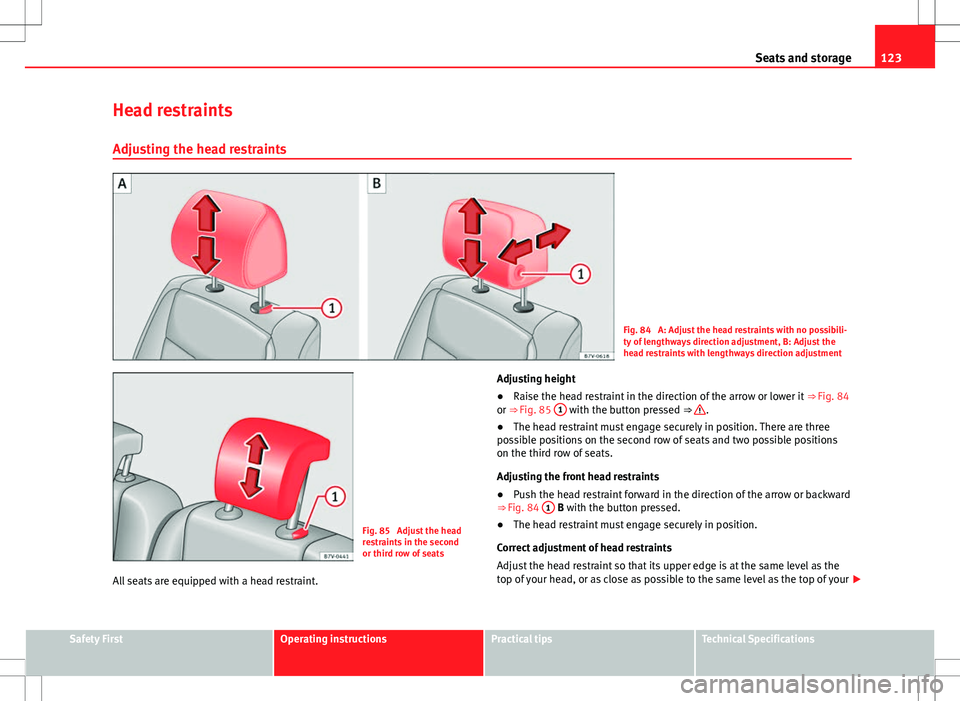
123
Seats and storage
Head restraints Adjusting the head restraints
Fig. 84 A: Adjust the head restraints with no possibili-
ty of lengthways direction adjustment, B: Adjust the
head restraints with lengthways direction adjustment
Fig. 85 Adjust the head
restraints in the second
or third row of seats
All seats are equipped with a head restraint. Adjusting height
●
Raise the head restraint in the direction of the arrow or lower it ⇒ Fig. 84
or ⇒ Fig. 85 1
with the button pressed ⇒ .
● The head restraint must engage securely in position. There are three
possible positions on the second row of seats and two possible positions
on the third row of seats.
Adjusting the front head restraints
● Push the head restraint forward in the direction of the arrow or backward
⇒ Fig. 84 1
B with the button pressed.
● The head restraint must engage securely in position.
Correct adjustment of head restraints
Adjust the head restraint so that its upper edge is at the same level as the
top of your head, or as close as possible to the same level as the top of your
Safety FirstOperating instructionsPractical tipsTechnical Specifications
Page 127 of 387
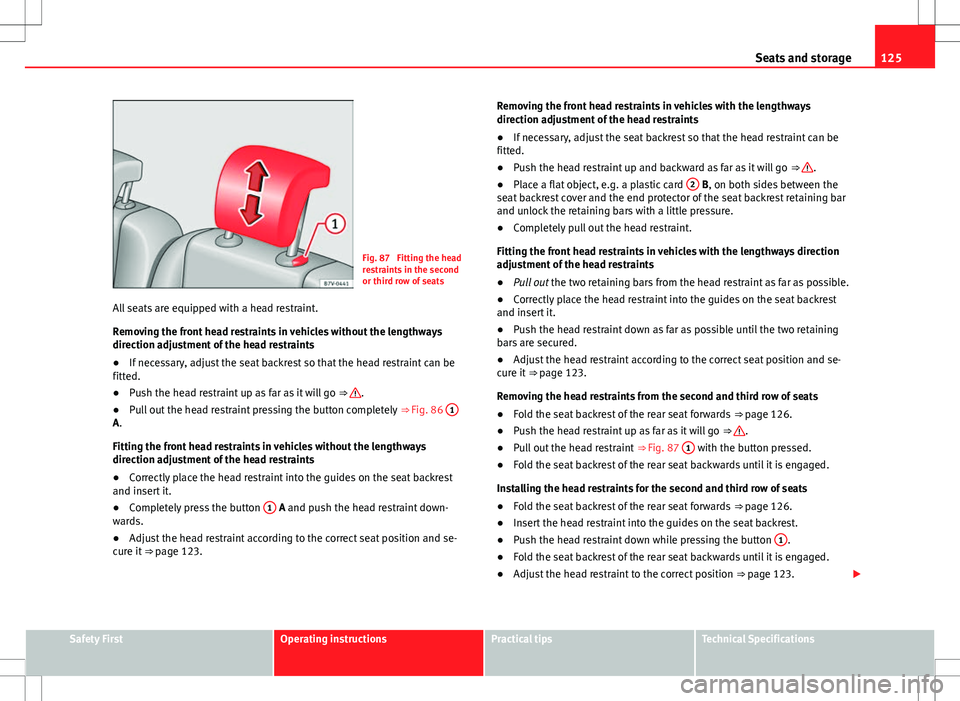
125
Seats and storage
Fig. 87 Fitting the head
restraints in the second
or third row of seats
All seats are equipped with a head restraint.
Removing the front head restraints in vehicles without the lengthways
direction adjustment of the head restraints
● If necessary, adjust the seat backrest so that the head restraint can be
fitted.
● Push the head restraint up as far as it will go
⇒
.
● Pull out the head restraint pressing the button completely
⇒ Fig. 86 1
A.
Fitting the front head restraints in vehicles without the lengthways
direction adjustment of the head restraints
●
Correctly place the head restraint into the guides on the seat backrest
and insert it.
● Completely press the button 1
A and push the head restraint down-
wards.
● Adjust the head restraint according to the correct seat position and se-
cure it ⇒ page 123. Removing the front head restraints in vehicles with the lengthways
direction adjustment of the head restraints
●
If necessary, adjust the seat backrest so that the head restraint can be
fitted.
● Push the head restraint up and backward as far as it will go ⇒
.
● Place a flat object, e.g. a plastic card 2 B, on both sides between the
seat backrest cover and the end protector of the seat backrest retaining bar
and unlock the retaining bars with a little pressure.
● Completely pull out the head restraint.
Fitting the front head restraints in vehicles with the lengthways direction
adjustment of the head restraints
● Pull out the two retaining bars from the head restraint as far as possible.
● Correctly place the head restraint into the guides on the seat backrest
and insert it.
● Push the head restraint down as far as possible until the two retaining
bars are secured.
● Adjust the head restraint according to the correct seat position and se-
cure it ⇒ page 123.
Removing the head restraints from the second and third row of seats
● Fold the seat backrest of the rear seat forwards ⇒ page 126.
● Push the head restraint up as far as it will go ⇒
.
● Pull out the head restraint ⇒ Fig. 87 1 with the button pressed.
● Fold the seat backrest of the rear seat backwards until it is engaged.
Installing the head restraints for the second and third row of seats
● Fold the seat backrest of the rear seat forwards ⇒ page 126.
● Insert the head restraint into the guides on the seat backrest.
● Push the head restraint down while pressing the button 1
.
● Fold the seat backrest of the rear seat backwards until it is engaged.
● Adjust the head restraint to the correct position ⇒ page 123.
Safety FirstOperating instructionsPractical tipsTechnical Specifications
Page 129 of 387

127
Seats and storage
WARNING
When the vehicle is not in use or being watched, always lock the doors
and the rear lid to reduce the risk of serious injury or death.
● Do not leave children unwatched, especially when the rear lid is open.
Children could climb into the luggage compartment, close the rear lid
from inside and be unable to escape themselves. This could lead to seri-
ous injury or death.
● Never allow children to play in or around the vehicle.
● Never transport people in the luggage compartment.
WARNING
Unsecured or incorrectly secured objects can cause serious injury in case
of a sudden manoeuvring or breaking or in case of an accident. This is es-
pecially true when objects are struck by a detonating airbag and fired
through the vehicle interior. To reduce the risks, please note the follow-
ing:
● Secure all objects in the vehicle. Always keep equipment and heavy
objects in the luggage compartment.
● Always secure objects with suitable rope or straps so that they can-
not enter the areas around the front or side airbags in case of sudden
braking or an accident.
● While driving, always keep object compartments closed.
WARNING (Continued)
● Do not place hard, heavy or sharp objects inside the vehicle interior,
in open storage compartments, the rear shelf or on the dash panel.
● Remove hard, heavy and sharp objects from clothes and pockets in-
side the vehicle and store securely.
WARNING
The transport of heavy object changes vehicle handling and increases
braking distance. Heavy loads that have not been stored or secured cor-
rectly could cause loss of control and result in serious injury.
● The vehicle handling changes when transporting heavy objects due
to a change in the centre of gravity.
● Distribute the load as uniformly and as low down on the vehicle as
possible.
● Store heavy objects in the luggage compartment as far from the rear
axle as possible.
CAUTION
● Hard objects on the rear shelf could chafe the wires of the heating ele-
ment and antenna of the rear window and cause damage.
● The side window antenna could be damaged due to chafing from ob-
jects.
Note
The ventilating slits between the heated rear window and the shelf must not
be covered so that used air can escape from the vehicle.
Safety FirstOperating instructionsPractical tipsTechnical Specifications
Page 131 of 387
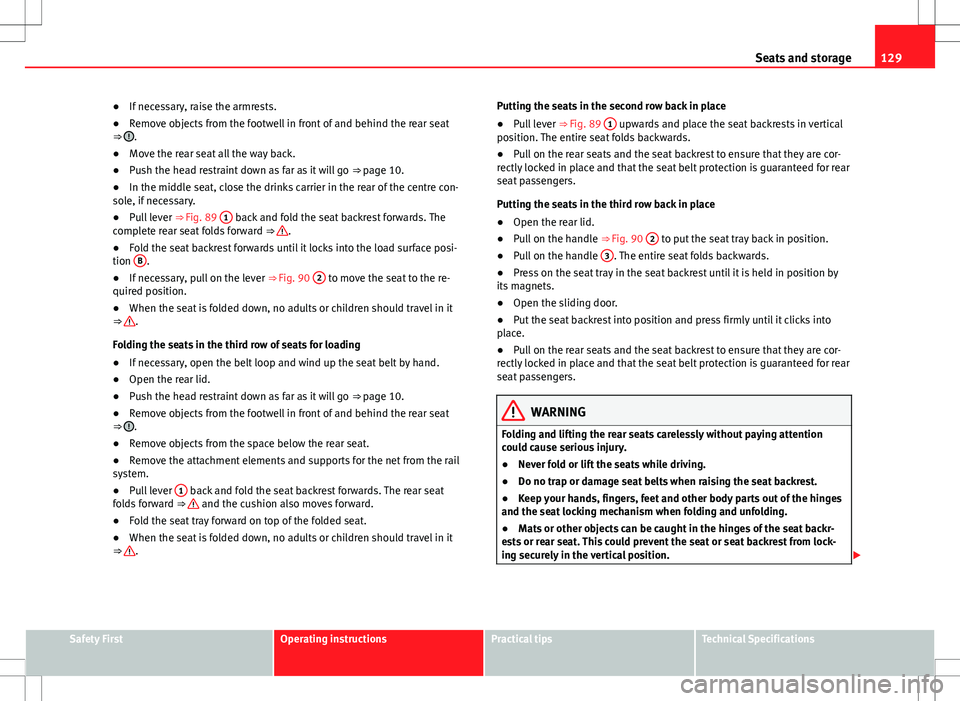
129
Seats and storage
● If necessary, raise the armrests.
● Remove objects from the footwell in front of and behind the rear seat
⇒
.
● Move the rear seat all the way back.
● Push the head restraint down as far as it will go ⇒ page 10.
● In the middle seat, close the drinks carrier in the rear of the centre con-
sole, if necessary.
● Pull lever ⇒ Fig. 89 1
back and fold the seat backrest forwards. The
complete rear seat folds forward ⇒ .
● Fold the seat backrest forwards until it locks into the load surface posi-
tion B
.
● If necessary, pull on the lever ⇒ Fig. 90 2 to move the seat to the re-
quired position.
● When the seat is folded down, no adults or children should travel in it
⇒
.
Folding the seats in the third row of seats for loading
● If necessary, open the belt loop and wind up the seat belt by hand.
● Open the rear lid.
● Push the head restraint down as far as it will go ⇒ page 10.
● Remove objects from the footwell in front of and behind the rear seat
⇒
.
● Remove objects from the space below the rear seat.
● Remove the attachment elements and supports for the net from the rail
system.
● Pull lever 1
back and fold the seat backrest forwards. The rear seat
folds forward ⇒ and the cushion also moves forward.
● Fold the seat tray forward on top of the folded seat.
● When the seat is folded down, no adults or children should travel in it
⇒
. Putting the seats in the second row back in place
●
Pull lever ⇒ Fig. 89 1
upwards and place the seat backrests in vertical
position. The entire seat folds backwards.
● Pull on the rear seats and the seat backrest to ensure that they are cor-
rectly locked in place and that the seat belt protection is guaranteed for rear
seat passengers.
Putting the seats in the third row back in place
● Open the rear lid.
● Pull on the handle ⇒ Fig. 90 2
to put the seat tray back in position.
● Pull on the handle 3. The entire seat folds backwards.
● Press on the seat tray in the seat backrest until it is held in position by
its magnets.
● Open the sliding door.
● Put the seat backrest into position and press firmly until it clicks into
place.
● Pull on the rear seats and the seat backrest to ensure that they are cor-
rectly locked in place and that the seat belt protection is guaranteed for rear
seat passengers.
WARNING
Folding and lifting the rear seats carelessly without paying attention
could cause serious injury.
● Never fold or lift the seats while driving.
● Do no trap or damage seat belts when raising the seat backrest.
● Keep your hands, fingers, feet and other body parts out of the hinges
and the seat locking mechanism when folding and unfolding.
● Mats or other objects can be caught in the hinges of the seat backr-
ests or rear seat. This could prevent the seat or seat backrest from lock-
ing securely in the vertical position.
Safety FirstOperating instructionsPractical tipsTechnical Specifications
Page 133 of 387
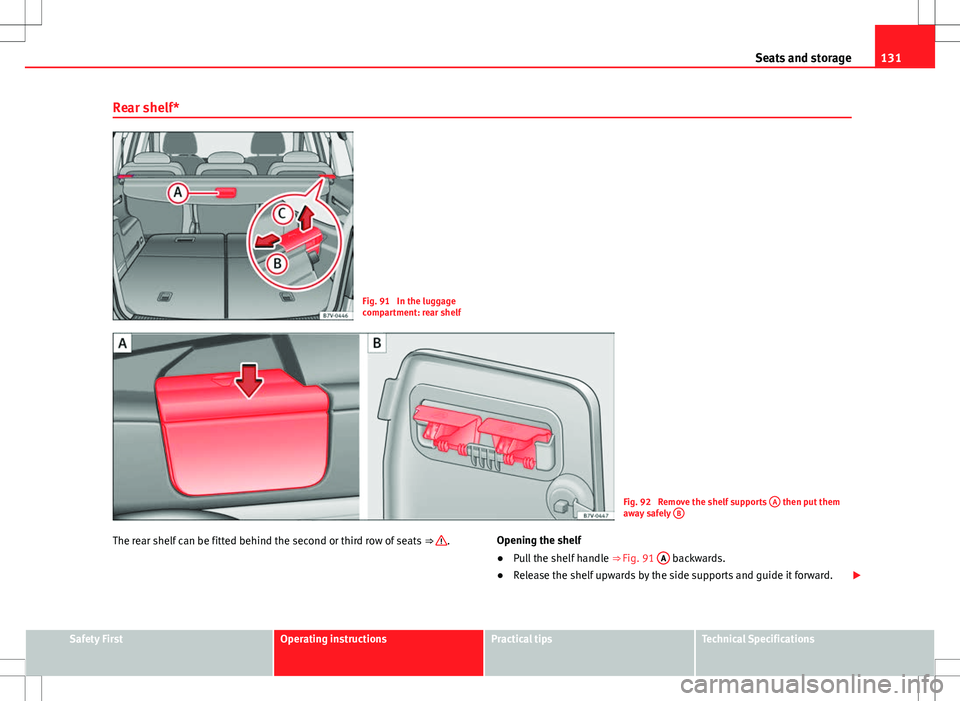
131
Seats and storage
Rear shelf*
Fig. 91 In the luggage
compartment: rear shelf
Fig. 92 Remove the shelf supports A then put them
away safely B
The rear shelf can be fitted behind the second or third row of seats
⇒ .Opening the shelf
●
Pull the shelf handle ⇒ Fig. 91 A backwards.
● Release the shelf upwards by the side supports and guide it forward.
Safety FirstOperating instructionsPractical tipsTechnical Specifications
Page 135 of 387
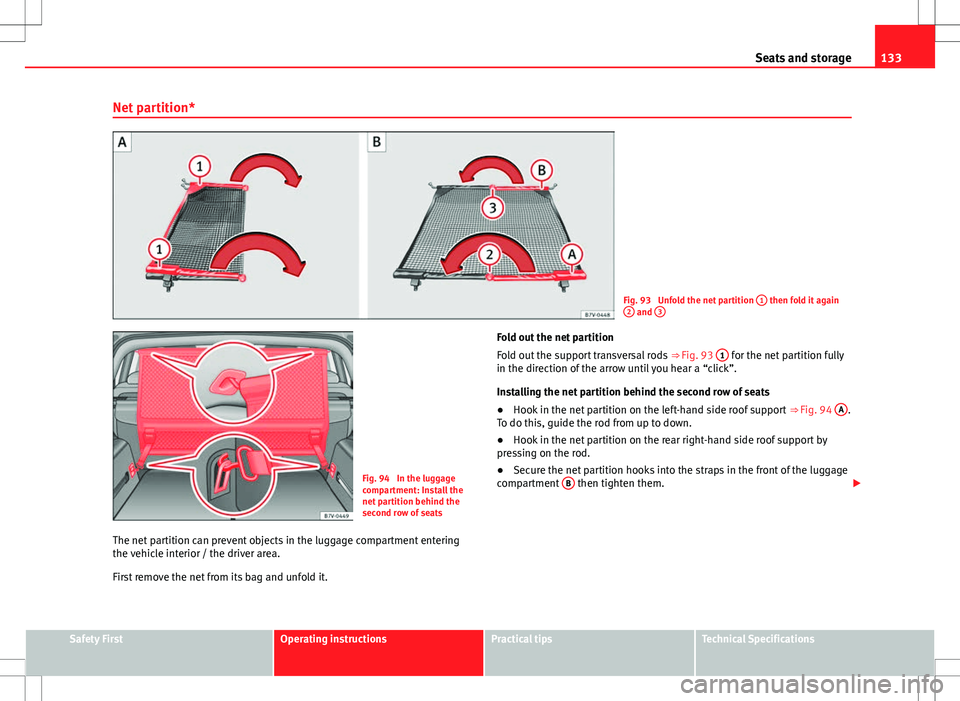
133
Seats and storage
Net partition*
Fig. 93 Unfold the net partition 1 then fold it again
2 and 3
Fig. 94 In the luggage
compartment: Install the
net partition behind the
second row of seats
The net partition can prevent objects in the luggage compartment entering
the vehicle interior / the driver area.
First remove the net from its bag and unfold it. Fold out the net partition
Fold out the support transversal rods
⇒ Fig. 93 1
for the net partition fully
in the direction of the arrow until you hear a “click”.
Installing the net partition behind the second row of seats
● Hook in the net partition on the left-hand side roof support ⇒ Fig. 94 A
.
To do this, guide the rod from up to down.
● Hook in the net partition on the rear right-hand side roof support by
pressing on the rod.
● Secure the net partition hooks into the straps in the front of the luggage
compartment B
then tighten them.
Safety FirstOperating instructionsPractical tipsTechnical Specifications
Page 137 of 387
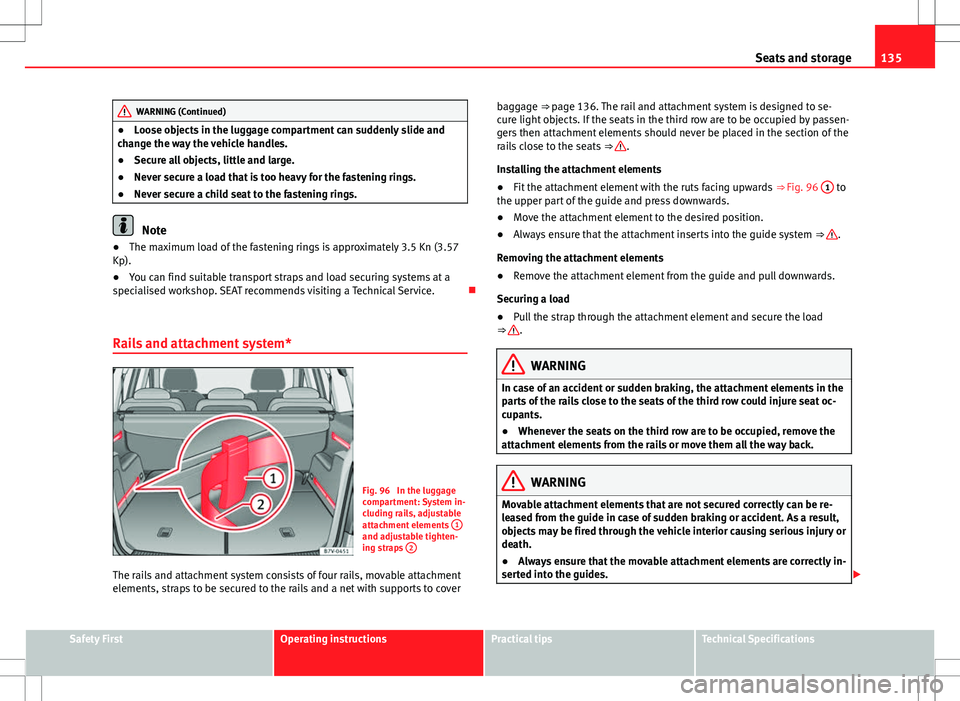
135
Seats and storage
WARNING (Continued)
● Loose objects in the luggage compartment can suddenly slide and
change the way the vehicle handles.
● Secure all objects, little and large.
● Never secure a load that is too heavy for the fastening rings.
● Never secure a child seat to the fastening rings.
Note
● The maximum load of the fastening rings is approximately 3.5 Kn (3.57
Kp).
● You can find suitable transport straps and load securing systems at a
specialised workshop. SEAT recommends visiting a Technical Service.
Rails and attachment system*
Fig. 96 In the luggage
compartment: System in-
cluding rails, adjustable
attachment elements 1
and adjustable tighten-
ing straps 2
The rails and attachment system consists of four rails, movable attachment
elements, straps to be secured to the rails and a net with supports to cover baggage ⇒ page 136. The rail and attachment system is designed to se-
cure light objects. If the seats in the third row are to be occupied by passen-
gers then attachment elements should never be placed in the section of the
rails close to the seats
⇒
.
Installing the attachment elements
● Fit the attachment element with the ruts facing upwards ⇒ Fig. 96 1
to
the upper part of the guide and press downwards.
● Move the attachment element to the desired position.
● Always ensure that the attachment inserts into the guide system ⇒
.
Removing the attachment elements
● Remove the attachment element from the guide and pull downwards.
Securing a load
● Pull the strap through the attachment element and secure the load
⇒
.
WARNING
In case of an accident or sudden braking, the attachment elements in the
parts of the rails close to the seats of the third row could injure seat oc-
cupants.
● Whenever the seats on the third row are to be occupied, remove the
attachment elements from the rails or move them all the way back.
WARNING
Movable attachment elements that are not secured correctly can be re-
leased from the guide in case of sudden braking or accident. As a result,
objects may be fired through the vehicle interior causing serious injury or
death.
● Always ensure that the movable attachment elements are correctly in-
serted into the guides.
Safety FirstOperating instructionsPractical tipsTechnical Specifications
Page 139 of 387
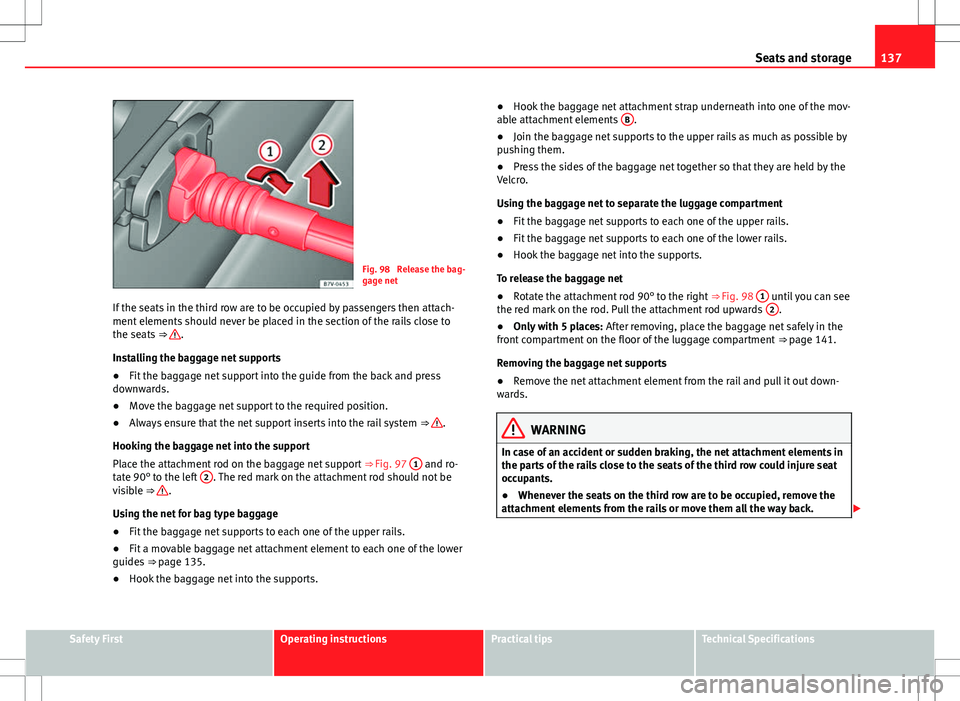
137
Seats and storage
Fig. 98 Release the bag-
gage net
If the seats in the third row are to be occupied by passengers then attach-
ment elements should never be placed in the section of the rails close to
the seats ⇒
.
Installing the baggage net supports
● Fit the baggage net support into the guide from the back and press
downwards.
● Move the baggage net support to the required position.
● Always ensure that the net support inserts into the rail system ⇒
.
Hooking the baggage net into the support
Place the attachment rod on the baggage net support ⇒ Fig. 97 1
and ro-
tate 90° to the left 2. The red mark on the attachment rod should not be
visible ⇒ .
Using the net for bag type baggage
● Fit the baggage net supports to each one of the upper rails.
● Fit a movable baggage net attachment element to each one of the lower
guides ⇒ page 135.
● Hook the baggage net into the supports. ●
Hook the baggage net attachment strap underneath into one of the mov-
able attachment elements B
.
● Join the baggage net supports to the upper rails as much as possible by
pushing them.
● Press the sides of the baggage net together so that they are held by the
Velcro.
Using the baggage net to separate the luggage compartment
● Fit the baggage net supports to each one of the upper rails.
● Fit the baggage net supports to each one of the lower rails.
● Hook the baggage net into the supports.
To release the baggage net
● Rotate the attachment rod 90° to the right ⇒ Fig. 98 1
until you can see
the red mark on the rod. Pull the attachment rod upwards 2.
● Only with 5 places: After removing, place the baggage net safely in the
front compartment on the floor of the luggage compartment ⇒ page 141.
Removing the baggage net supports
● Remove the net attachment element from the rail and pull it out down-
wards.
WARNING
In case of an accident or sudden braking, the net attachment elements in
the parts of the rails close to the seats of the third row could injure seat
occupants.
● Whenever the seats on the third row are to be occupied, remove the
attachment elements from the rails or move them all the way back.
Safety FirstOperating instructionsPractical tipsTechnical Specifications
Page 141 of 387
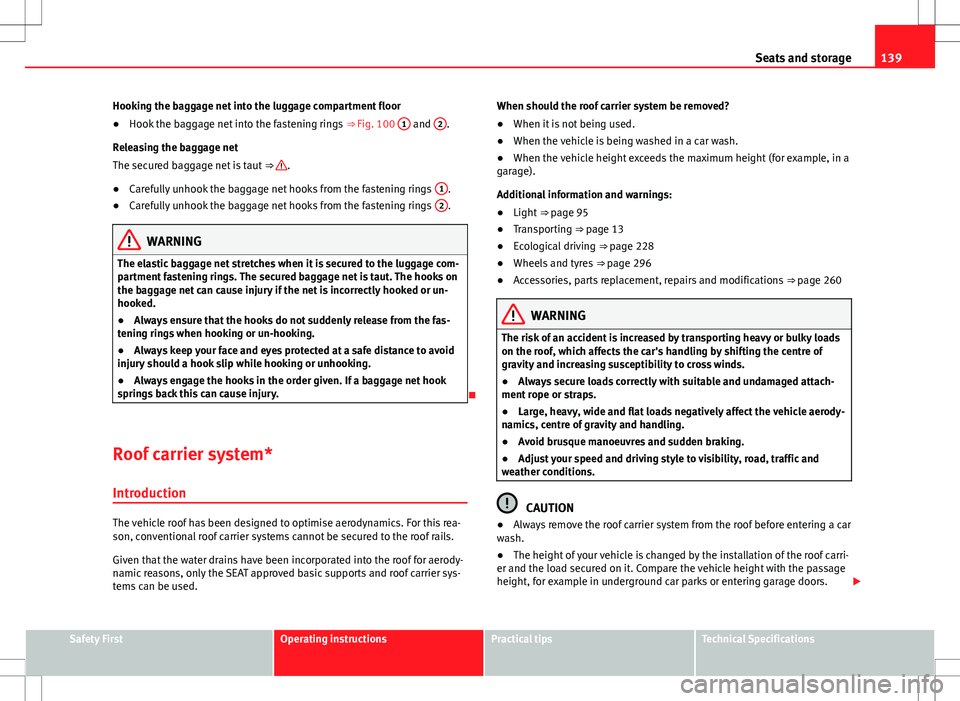
139
Seats and storage
Hooking the baggage net into the luggage compartment floor
● Hook the baggage net into the fastening rings ⇒ Fig. 100 1
and 2.
Releasing the baggage net
The secured baggage net is taut ⇒
.
● Carefully unhook the baggage net hooks from the fastening rings 1
.
● Carefully unhook the baggage net hooks from the fastening rings 2.
WARNING
The elastic baggage net stretches when it is secured to the luggage com-
partment fastening rings. The secured baggage net is taut. The hooks on
the baggage net can cause injury if the net is incorrectly hooked or un-
hooked.
● Always ensure that the hooks do not suddenly release from the fas-
tening rings when hooking or un-hooking.
● Always keep your face and eyes protected at a safe distance to avoid
injury should a hook slip while hooking or unhooking.
● Always engage the hooks in the order given. If a baggage net hook
springs back this can cause injury.
Roof carrier system* Introduction
The vehicle roof has been designed to optimise aerodynamics. For this rea-
son, conventional roof carrier systems cannot be secured to the roof rails.
Given that the water drains have been incorporated into the roof for aerody-
namic reasons, only the SEAT approved basic supports and roof carrier sys-
tems can be used. When should the roof carrier system be removed?
●
When it is not being used.
● When the vehicle is being washed in a car wash.
● When the vehicle height exceeds the maximum height (for example, in a
garage).
Additional information and warnings:
● Light ⇒ page 95
● Transporting ⇒ page 13
● Ecological driving ⇒ page 228
● Wheels and tyres ⇒ page 296
● Accessories, parts replacement, repairs and modifications ⇒ page 260
WARNING
The risk of an accident is increased by transporting heavy or bulky loads
on the roof, which affects the car's handling by shifting the centre of
gravity and increasing susceptibility to cross winds.
● Always secure loads correctly with suitable and undamaged attach-
ment rope or straps.
● Large, heavy, wide and flat loads negatively affect the vehicle aerody-
namics, centre of gravity and handling.
● Avoid brusque manoeuvres and sudden braking.
● Adjust your speed and driving style to visibility, road, traffic and
weather conditions.
CAUTION
● Always remove the roof carrier system from the roof before entering a car
wash.
● The height of your vehicle is changed by the installation of the roof carri-
er and the load secured on it. Compare the vehicle height with the passage
height, for example in underground car parks or entering garage doors.
Safety FirstOperating instructionsPractical tipsTechnical Specifications
Page 143 of 387
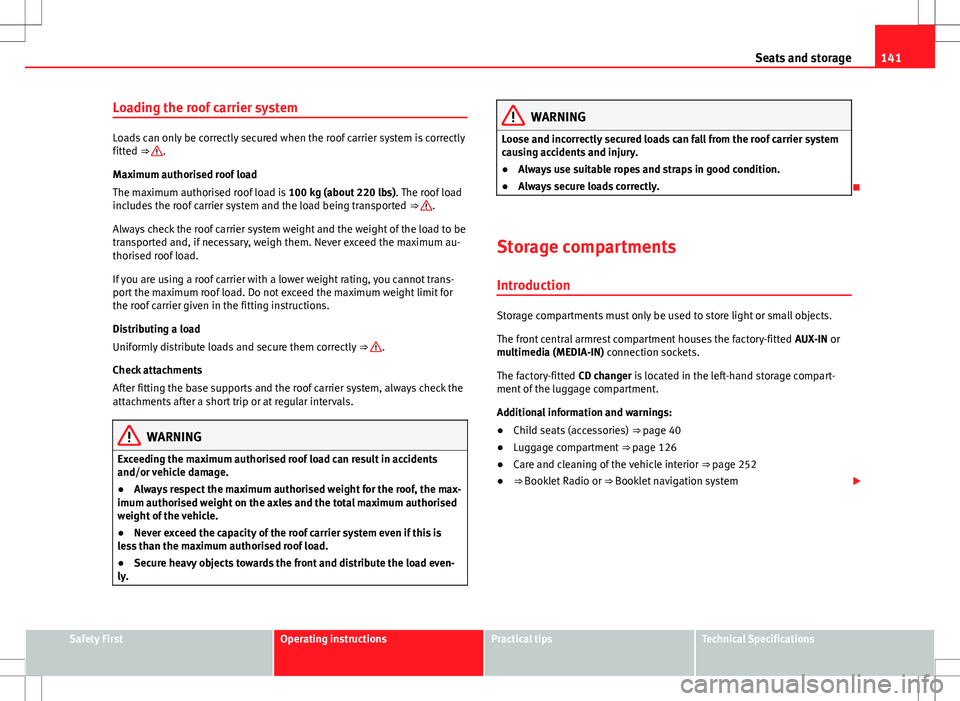
141
Seats and storage
Loading the roof carrier system
Loads can only be correctly secured when the roof carrier system is correctly
fitted ⇒ .
Maximum authorised roof load
The maximum authorised roof load is 100 kg (about 220 lbs). The roof load
includes the roof carrier system and the load being transported ⇒
.
Always check the roof carrier system weight and the weight of the load to be
transported and, if necessary, weigh them. Never exceed the maximum au-
thorised roof load.
If you are using a roof carrier with a lower weight rating, you cannot trans-
port the maximum roof load. Do not exceed the maximum weight limit for
the roof carrier given in the fitting instructions.
Distributing a load
Uniformly distribute loads and secure them correctly ⇒
.
Check attachments
After fitting the base supports and the roof carrier system, always check the
attachments after a short trip or at regular intervals.
WARNING
Exceeding the maximum authorised roof load can result in accidents
and/or vehicle damage.
● Always respect the maximum authorised weight for the roof, the max-
imum authorised weight on the axles and the total maximum authorised
weight of the vehicle.
● Never exceed the capacity of the roof carrier system even if this is
less than the maximum authorised roof load.
● Secure heavy objects towards the front and distribute the load even-
ly.
WARNING
Loose and incorrectly secured loads can fall from the roof carrier system
causing accidents and injury.
● Always use suitable ropes and straps in good condition.
● Always secure loads correctly.
Storage compartments Introduction
Storage compartments must only be used to store light or small objects.
The front central armrest compartment houses the factory-fitted AUX-IN or
multimedia (MEDIA-IN) connection sockets.
The factory-fitted CD changer is located in the left-hand storage compart-
ment of the luggage compartment.
Additional information and warnings:
● Child seats (accessories) ⇒ page 40
● Luggage compartment ⇒ page 126
● Care and cleaning of the vehicle interior ⇒ page 252
● ⇒ Booklet Radio or ⇒ Booklet navigation system
Safety FirstOperating instructionsPractical tipsTechnical Specifications